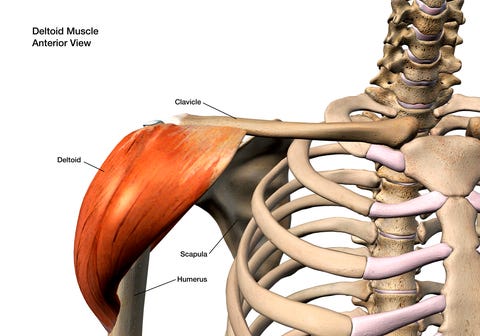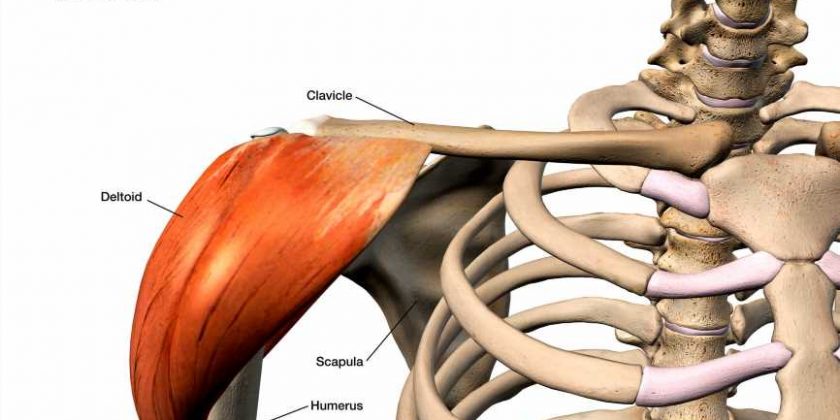You’re scrolling through TikTok trying to get some inspiration for your next workout. Maybe you see a new ab circuit, a new squat variation or a new pre-workout supplement that a muscle-bound bro is endorsing. Swipe up once more, and you stumble on a fitness pro telling you to scrap a movement you have been doing for years. Front delt training isn’t necessary, they say. Does that idea hold water, or is this a case of a social media galaxy brain overreach?
Search the term on the social platform, and you’ll find a mix of clips either breaking down dedicated training splits to hammer the muscle group, or arguing that you should stay away from isolated front delt training entirely. But in a 15-second video, a lot of nuance and information can be left out of the frame, leaving the viewer confused about how to structure their shoulder training.
The coaches advocating for largely abstaining from front delt isolation aren’t wrong (just check out our own video about dumbbell front raises). They just need to explain their thinking more effectively. Men’s Health fitness director Ebenezer Samuel C.S.C.S. agrees with the message these trainers are sending, but hopes that they can communicate better with their audience. According to Samuel, there’s no such thing as a bad exercise, but “there are exercises that are counterproductive for certain body types and for certain goals.”
What Are the Front Delts, Anyway?
The deltoid muscles consist of three parts: the anterior (front) deltoid, lateral (medial) deltoid, and posterior (back) deltoid. The anterior deltoid makes up the front head of the shoulder, and rotates the shoulder joint by drawing the arm inward.

What Experts Say About Training Your Shoulders
For Samuel and sports performance specialist and injury prevention expert Dr. John Rusin, isolating the front delts is an antiquated practice at best and a risky decision at worst. Front delt moves rarely make the cut in their shoulder training regimens for a few reasons.
Both Rusin and Samuel agree that shoulders are frequently an overtrained muscle group. Whether stabilizing the arm to target your biceps with a curl, or moving your elbows behind your torso to attack the back, your shoulders are used to stabilize your arms for these movements. This is even more apparent when examining the anterior delts.
When you are doing any pressing movements, Rusin says the anterior deltoids are highly active. This is especially present with higher loaded pressing, and a big reason that heavy pressing works well for training the shoulders. Following that logic, most common training splits include plenty of pressing movements in order to target the whole shoulder.
Samuel agrees. The shoulders are getting plenty of activation in other movements, he says, so it’s best to train the muscle group—specifically the front delts—strategically to limit the risk of injury. “There is a lot of room for rotator cuff tendons to pinch in that position,” Samuel says of training to specifically isolate your front delts. Since the muscle is already being worked in pressing movements, any extra isolation exercises could risk further strain.
How You Should Fit Shoulder Training Into Your Workout
So where does the advice of TikTok trainers fit into the training split? If the influencers are calling for a total kibosh on the front delts, take a beat before following their advice to the letter. Samuel says you don’t have to skip out on front delt isolation completely. Instead, make it the lowest priority in your shoulder training. Check out these four exercises for your shoulders to start.
After that, it’s really up to your fitness goals. Are you a gym rat just looking for a complete program? Maybe skip it. Are you a bodybuilding competitor yearning for a set of 3D shoulders for the show stage? You might be in a better spot to include some dedicated front delt action into your training.
Even if you do fit that latter category, Samuel says to still be wary of overtraining your front delts. Instead, you should prioritize targeting the lateral head first, and then work on strengthening your rear delts. If you still have time, throw in a front raise maybe once a week to give those front shoulders an extra pump. Here are a few tips to do the exercise safely provided by Samuel and fitness editor Brett Williams to properly train those front delts.
Source: Read Full Article
